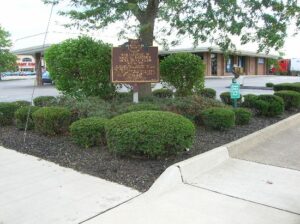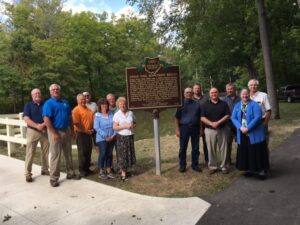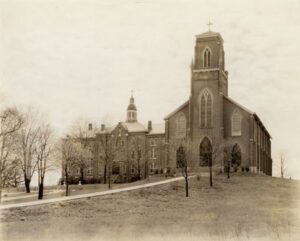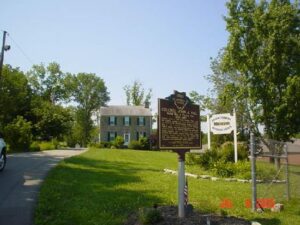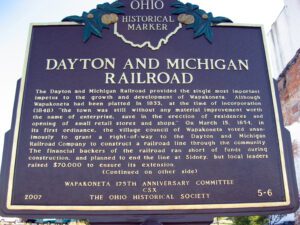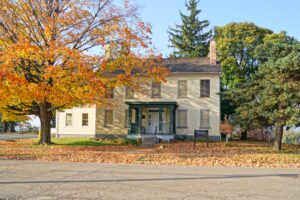, OH
On this site in October of 1870 met a group of enlightened individuals dedicated to the reformation and improvement of penal systems. This first Congress of the National Prison Association, now known as the American Correctional Association, adopted a far-sighted philosophy of corrections. This philosophy, embodied in its Declaration of Principles, remains today as the basic guide for modern correctional systems.
, OH
On this site stood the Main Gatehouse of the Anna Dean Farm, estate of Barberton town founder and industrialist Ohio C. Barber. The Anna Dean Farm was not only a lavish estate but also a farming showcase built to promote and develop scientific agricultural practices in the United States.
, OH
Zenas King (1818-1892) was a 19th century bridge builder whose iron bridges received wide acceptance throughout the country. He developed his tubular bowstring bridge in 1859, patented the design in 1861, renewed the patent in 1867, and founded King Iron Bridge & Manufacturing Company in 1871. Based on an arch’s inherent strength, King’s design used less raw materials than wooden bridges and the square tubes were simple to fabricate and ship for on-site assembly. His Cleveland-based company soon built so many patent bowstrings across Ohio that it set a design standard. (Continued on other side)
, OH
The oldest commercial enterprise in Ohio, the Chillicothe Gazette began publication on April 25, 1800, as Freeman’s Journal and Chillicothe Advertiser. That October it became the Scioto Gazette, and Chillicothe has had a Gazette ever since. It is the oldest newspaper in continuous operation west of the Allegheny Mountains, and the second oldest in the United States. Its first publisher and editor, Nathaniel Willis, was a Revolution-era Boston printer who reputedly apprenticed under Benjamin Franklin. Under his leadership the Gazette became one of the most influential papers in the expanding West. It first reported news transmitted by telegraph in 1847 and began daily publication in 1849. The Gazette moved into this building, a replica of Ohio’s first statehouse, in 1941.
, OH
St. Joseph Catholic Church, called the cradle of the faith in Ohio, was the first Catholic church in the state. In 1809, Jacob and Catharine Dittoe deeded Father Edward Fenwick, who had traveled from Kentucky, 320 acres of ground to build the church. The original church, dedicated on December 6, 1818, by Father Fenwick and Father Nicholas Dominic Young, was a log cabin with a bare dirt floor measuring 18 feet by 22 feet. Father Fenwick was soon installed as the first Bishop of Cincinnati. Construction on the present church began in 1839.
, OH
Colonel John J. Voll from Goshen, Ohio, was the highest scoring ace of the 15th U.S. Army Air Force in the Mediterranean theater of World War II. As a Captain flying a P-51 Mustang fighter plane, he was credited with twenty-one aerial victories. His superior skill in one particular battle enabled him to maneuver three enemy aircraft into crashes without firing a shot. On a separate mission, while flying solo, Captain Voll had four confirmed kills, two probables, and damaged two additional enemy planes. (continued on other side)
, OH
The Dayton and Michigan Railroad provided the single most important impetus to the growth and development of Wapakoneta. Although Wapakoneta had been platted in 1833, at the time of incorporation (1848), “the town was still without any material improvement worth the name of enterprise, save in the erection of residences and opening of small retail stores and shops.” On March 15, 1854, in its first ordinance, the village council of Wapakoneta voted unanimously to grant a right-of-way to the Dayton and Michigan Railroad Company to construct a railroad line through the community. The financial backers of the railroad ran short of funds during construction, and planned to end the line at Sidney, but local leaders raised $70,000 to ensure its extension. (Continued on other side)
, OH
Built in the 1840s by William and Catharine Hubbard and known as “Mother Hubbard’s Cupboard” or “The Great Emporium” by fugitive slaves, the Hubbard House was an important terminus on the fabled Underground Railroad in the years before the Civil War. The Hubbard House sheltered escaped slaves who had risked life and limb after crossing the Ohio River into the North. From the Hubbard home, slaves walked one-quarter mile to the Hubbard and Company warehouse on the Ashtabula River, where friendly boat captains awaited to ferry their passengers to Canada and freedom. The U.S. Department of the Interior listed the Hubbard House on its National Register of Historic Places in 1973.



